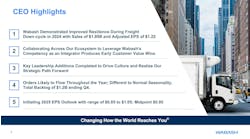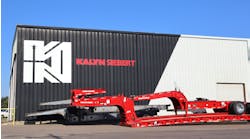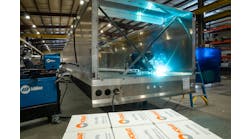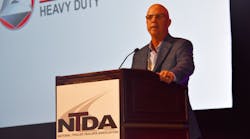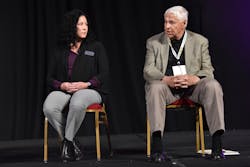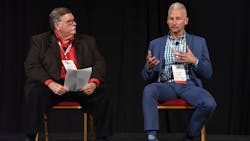When it came time to come up with a topic for discussion at this year’s NTDA convention, a current concern quickly rose to the top: the supply chain, as moderator Bill Schaffer, vice president of sales for Overseas Hardwoods Co., explained in introducing the panel. But that’s still a broad topic.
“With all the geopolitical forces that are out there, with coming out and COVID, with trying to figure out what to do with the supply chain and all the disruptions in labor—the list goes on and on,” Schaffer said.
So the discussion was shaped around three key categories: capacity, stability, and sustainability.
And, to provide a wide range of perspective on these challenges, panel participants were:
- Rick Quinn, executive vice president, Steel Warehouse
- Jerrod Heft, vice president, commercial transportation and sustainability, Hydro Extrusion; and
- Shelley Sheagley, senior vice president of product and marketing, Aurora Parts.
First up, Sheagley—representing an aftermarket parts distributor—tackled the issue of supply shortages.
“I've never seen the allocation issues that we've been having these past couple of years,” she said. “When a company is trying to grow, it's hard to be constrained—so we've had to deal with these allocations on certain product lines. We've had to realize not only how we buy those product lines, we have to make sure we have enough product for our dealers, and make sure that we're distributing it fairly.”
The trick, she continued, is deciding how to live with these shortages and allocations, or to find additional supply. Of course, if there’s just one supplier in the market, “you deal with what you have.”
Steel and aluminum are critical for trailer manufacturers, of course—but explaining the aluminum market dynamics since the pandemic began is complicated, and “a bit of a long story,” offered Hoeft. He noted that when he came into the industry in the mid-1990s, extrusion allocations were the result of “fundamental supply and demand.”
“This time around, allocation is different because there have been fundamental structural changes, post-pandemic,” Hoeft said. “In the aluminum world, demand skyrocketed. It’s a very global market. But, since the Great Recession the industry has been really undercapitalized, in terms of adding capacity. So material shortages and labor challenges, combined with that lack of investment—particularly in North America—and now you’ve got a bigger problem and one that isn’t going to solve itself very quickly. It's been very difficult for us to manage allocation to customers, but it’s causing North American manufacturers to think long term and invest heavily for the future.”
Making the aluminum situation even more challenging, the already constrained production capacity is facing even greater demand, expect to grown by hundreds of millions of pounds in the few years, Hoeft continued. Additionally, the extrusion presses are very complex—and expensive.
“These are $50-million-plus machines,” Heoft said. “And because of COVID, now it takes two or three years to put in just one single press. I’m not trying to scare people; I believe capitalism is finally going to manage this and we'll ultimately catch up. But also, I want to ground this in the reality that challenge is different this time.”
For steel, however, the problem is “remarkably different,” added Quinn. “The roots of allocations that we experienced two years ago were really set in the early 50s.”
At that time, domestic steel capacity was just over 80 million tons; today, it’s 120 million—but that’s not enough, as growing demand has resulted in a 20% market shortfall, he explained. Additionally, in 2000 the U.S. had 21 steel mills, and the top 15 controlled about 70% of production. Today, four of the remaining six steel mills control that 70%.
“And when there's only four controlling 70%, they're chasing margin—and that's a remarkably different environment,” Quinn said.
Additionally, allocations are the result of “uncertainty” due to demand swings in the market—so steel buyers need to manage orders accordingly.
He did note that 2022 will mark an increase in domestic flat-rolled steel capacity, however, with about 6 million tons of new capacity coming on line by 2025.
Inflation concerns
Schaffer noted that the pandemic and recovery brought attention to “ancillary costs” that previously weren’t focused on. For the lumber industry, for example, the cost of packaging has skyrocketed. What additional costs are supplier having to bear that customers should understand—and plan for?
For Hoeft, aluminum manufacturers are facing soaring costs for employee health and wellness benefits, as well as energy. Additionally, the cost of alloy materials needed to make aluminum, such as magnesium, are “skyrocketing.” And even the components that go into making paint are significantly higher.
“I've been around 28 years and we all get excited during these ups and downs, but one thing that has always happened is things that go up will always come down—but I do think things have changed,” Hoeft said. “I don't think I think inflation will come down. We'll be somewhere in that 3% to 5% inflation range in the next several years, versus the 2% before the pandemic.”
For distributors like Aurora Parts, acquiring additional warehouse space to meet customer expectations for fast delivery is costly. And packaging costs have gone up.
“'We’re trying to be smarter about what we do with that packaging, and get it returned,” Sheagley said. “So as we get closer to our customers, we can do those milk runs and we can bring back pallets and packaging.”
Additionally, she expects labor costs to remain high.
“Once you start increasing wages, it's hard to step back,” she said.
The steel industry also is increasingly focused on packaging.
“Our customers are asking us about our green initiatives, and how that applies to our packaging,” Quinn said. “The key to return packaging is putting together a logistical plan. And I think that that will bleed over into other commodities—not just shipping the final product, but also the components of that product.”
Green initiatives
Indeed, the panel concluded with a discussion of the impact of environmental policies.
Globally, the steel industry produced 1.9 billion tons of steel, and created 3.6 billion tons of CO2, or a ratio of about 1.6 tons of CO2 for every ton of steel. The U.S. is “really ahead of the curve,” with a ratio of about 1:1, while China is nearly 3:1, Quinn explained. Historically, the open hearth furnace process had a ratio of 15:1, while more modern bottom loading furnaces cut that to 1.8:1. The latest electric arc furnace technology produces only 0.4 tons of CO2 per ton of steel.
“It's transforming the way steel's made today, versus how it was made just 15 to 20 years ago, and it's taken that CO2 out of the system,” Quinn said. “There are two mills in Sweden that will have zero CO2 emissions.”
But green steel is more expensive to produce—and ultimately the customer, then the consumer, will have to foot the bill.
“The customers are asking, ‘what’s your green strategy?’ because they’ve all made commitments in terms of how they’re going to reduce their carbon footprint,” Quinn said. “And that footprint pressure is going to come all the way down the supply base, including asking us how we’re going to change the way we use our support wood as part of our packaging. It's going to get that detailed, in my opinion, in the next five years.”
Hoeft agreed.
“Ultimately, customers are going to be asking for three things:They're going to want to know your carbon footprint; they're going to want to know about recycled content; and they're going want to know how you can help them design sustainability into their products,” Hoeft said. “And, again, like everything else, it's big and it's complex. Hydro is going to be investing $1 billion into the green transition. We're vertically integrated—from bauxite, aluminum smelting, casting, and discribution—but, in total, it’s a billion dollars between now and when we declared net zero. So it's coming.”
What is this going to mean “upstream”? For aluminum, much of the CO2 contribution is in the raw materials, so the industry is focused on carbon capture technology and using renewable energy.
“The other thing that that most North American companies are going to have to do is have a green sourcing strategy, a green manufacturing strategy, and a green product strategy,” Hoeft said. “Like ISO certification when it became popular, you have to have it to be supplier. And, similarly, you're going to have to have some data transparency to show your footprint, and to work with your customers to help them achieve their goals.
“So it's coming. It's going take a lot of investment and it's going take time.”

